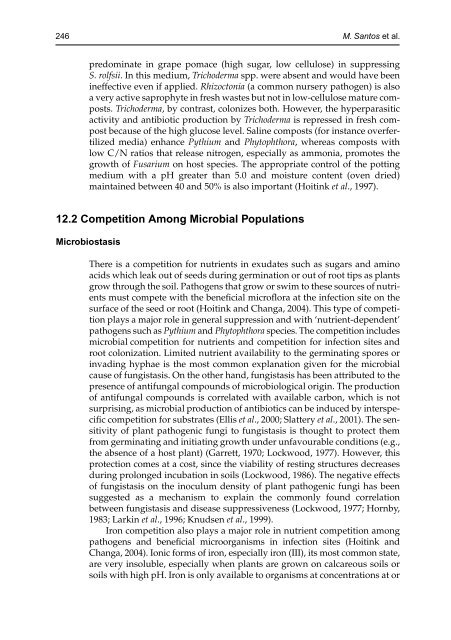natural-products-in-plant-pest-management
natural-products-in-plant-pest-management
natural-products-in-plant-pest-management
Create successful ePaper yourself
Turn your PDF publications into a flip-book with our unique Google optimized e-Paper software.
246 M. Santos et al.predom<strong>in</strong>ate <strong>in</strong> grape pomace (high sugar, low cellulose) <strong>in</strong> suppress<strong>in</strong>gS. rolfsii. In this medium, Trichoderma spp. were absent and would have been<strong>in</strong>effective even if applied. Rhizoctonia (a common nursery pathogen) is alsoa very active saprophyte <strong>in</strong> fresh wastes but not <strong>in</strong> low-cellulose mature composts.Trichoderma, by contrast, colonizes both. However, the hyperparasiticactivity and antibiotic production by Trichoderma is repressed <strong>in</strong> fresh compostbecause of the high glucose level. Sal<strong>in</strong>e composts (for <strong>in</strong>stance overfertilizedmedia) enhance Pythium and Phytophthora, whereas composts withlow C/N ratios that release nitrogen, especially as ammonia, promotes thegrowth of Fusarium on host species. The appropriate control of the pott<strong>in</strong>gmedium with a pH greater than 5.0 and moisture content (oven dried)ma<strong>in</strong>ta<strong>in</strong>ed between 40 and 50% is also important (Hoit<strong>in</strong>k et al., 1997).12.2 Competition Among Microbial PopulationsMicrobiostasisThere is a competition for nutrients <strong>in</strong> exudates such as sugars and am<strong>in</strong>oacids which leak out of seeds dur<strong>in</strong>g germ<strong>in</strong>ation or out of root tips as <strong>plant</strong>sgrow through the soil. Pathogens that grow or swim to these sources of nutrientsmust compete with the beneficial microflora at the <strong>in</strong>fection site on thesurface of the seed or root (Hoit<strong>in</strong>k and Changa, 2004). This type of competitionplays a major role <strong>in</strong> general suppression and with ‘nutrient-dependent’pathogens such as Pythium and Phytophthora species. The competition <strong>in</strong>cludesmicrobial competition for nutrients and competition for <strong>in</strong>fection sites androot colonization. Limited nutrient availability to the germ<strong>in</strong>at<strong>in</strong>g spores or<strong>in</strong>vad<strong>in</strong>g hyphae is the most common explanation given for the microbialcause of fungistasis. On the other hand, fungistasis has been attributed to thepresence of antifungal compounds of microbiological orig<strong>in</strong>. The productionof antifungal compounds is correlated with available carbon, which is notsurpris<strong>in</strong>g, as microbial production of antibiotics can be <strong>in</strong>duced by <strong>in</strong>terspecificcompetition for substrates (Ellis et al., 2000; Slattery et al., 2001). The sensitivityof <strong>plant</strong> pathogenic fungi to fungistasis is thought to protect themfrom germ<strong>in</strong>at<strong>in</strong>g and <strong>in</strong>itiat<strong>in</strong>g growth under unfavourable conditions (e.g.,the absence of a host <strong>plant</strong>) (Garrett, 1970; Lockwood, 1977). However, thisprotection comes at a cost, s<strong>in</strong>ce the viability of rest<strong>in</strong>g structures decreasesdur<strong>in</strong>g prolonged <strong>in</strong>cubation <strong>in</strong> soils (Lockwood, 1986). The negative effectsof fungistasis on the <strong>in</strong>oculum density of <strong>plant</strong> pathogenic fungi has beensuggested as a mechanism to expla<strong>in</strong> the commonly found correlationbetween fungistasis and disease suppressiveness (Lockwood, 1977; Hornby,1983; Lark<strong>in</strong> et al., 1996; Knudsen et al., 1999).Iron competition also plays a major role <strong>in</strong> nutrient competition amongpathogens and beneficial microorganisms <strong>in</strong> <strong>in</strong>fection sites (Hoit<strong>in</strong>k andChanga, 2004). Ionic forms of iron, especially iron (III), its most common state,are very <strong>in</strong>soluble, especially when <strong>plant</strong>s are grown on calcareous soils orsoils with high pH. Iron is only available to organisms at concentrations at or


